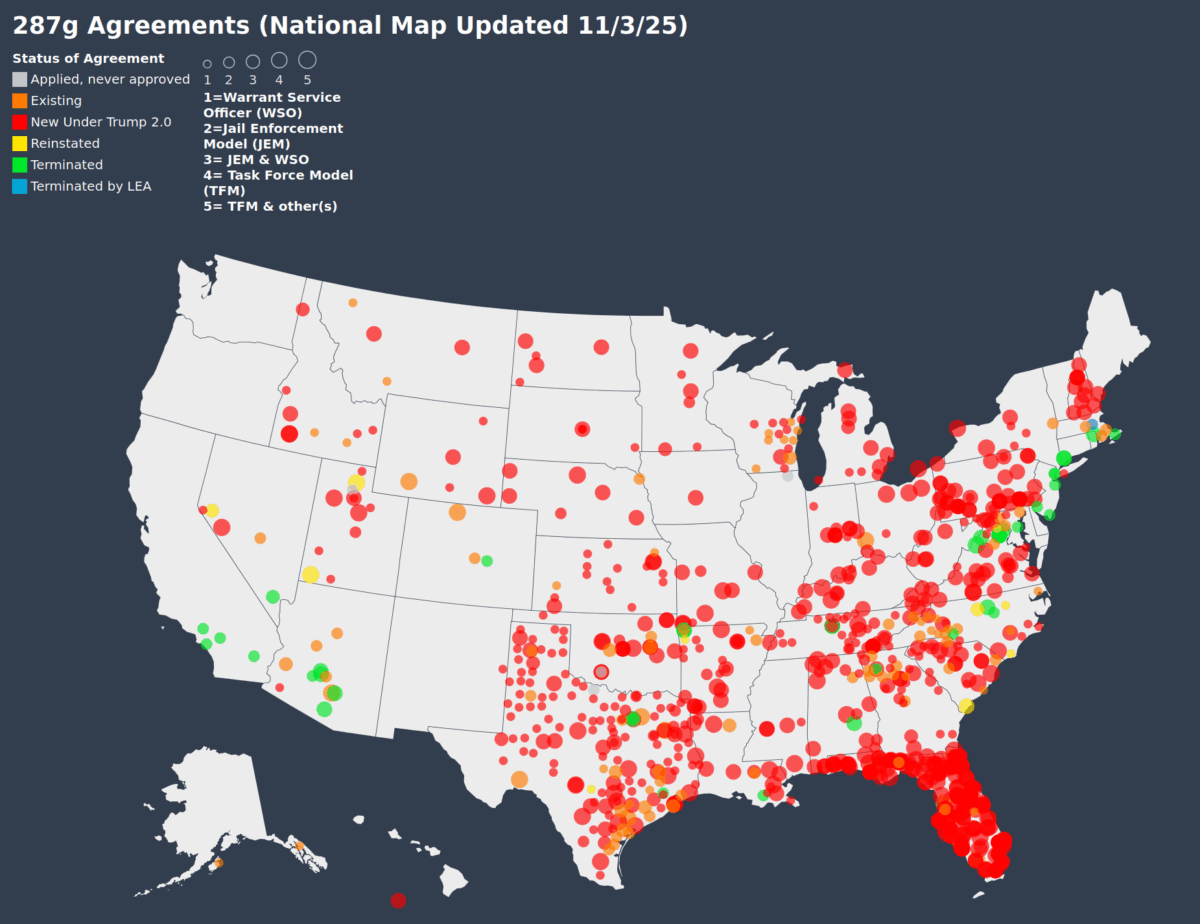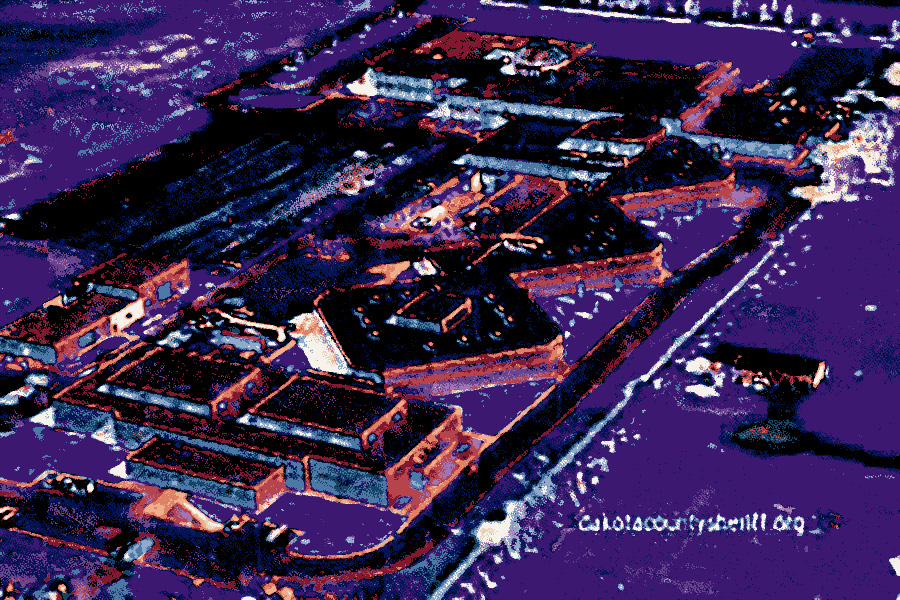Local ‘Participating Agencies’ Expand ICE Links in Minnesota as Counties Profit from Immigrant Detentions
The 287(g) program links local law enforcement agencies, even down to the level of college police departments, into ICE; as we reported earlier this year, it’s steadily been expanding. Across 40 states in the country, as of November 21, there are 1,189 Memorandums of Agreement. Since May, the program has grown incrementally in Minnesota. Sherburne County joined the “Jail Enforcement Model” in October, and Mille Lacs County joined the “Task Force Model” in June. Kandiyohi County joined the “Warrant Service Officer” model in March; Itasca joined the Task Force program in February; Crow Wing County joined both the Task Force and Warrant Service programs in March, and Cass County joined the Task Force program in February.
2019 Coverage: Twin Cities Jewish Community Blockades ICE Building, 27 Cited
ICE pays for detention facility beds on a “per diem” or daily arrangement, about $165 a day, according to Marketplace, although this varies widely. The biggest major private prison vendors are CoreCivic and GEO Group — and despite huge rises in their stock prices, they are drifting lower, even after getting juiced by management stock buybacks and seemingly endless increases in immigrant detentions under the Trump administration this year. CoreCivic hit a 52-week low, and GEO Group has dropped 47% since a year ago amid weaker revenue than expected.
The revenue bonanza for GEO Group and CoreCivic got turbocharged during the Biden administration, according to the ACLU, and the former president did not wind down the role of private prisons for immigration detentions, even as investigations showed human rights abuses mounted at many facilities. The Trump administration has helped create “perverse” incentives for local governments to get into the “deportation business,” according to a report early this year by the Marshall Project. NBC News profiled how Ohio’s Butler County was cashing in on this business. In Clay County, Indiana, this has become a “major revenue source.”
Some groups in Minnesota have been working against this kind of “deputization,” including the Minnesota Interfaith Coalition on Immigration (ICOM). The ACLU of Minnesota has a resource page about opposing 287(g). Here are their arguments against local law enforcement linking up to ICE via 287(g):
ACLU MN Stop 287(g) Agreements page
- 287(g) agreements waste taxpayer money by potentially impacting local law enforcement budgets as well as pulling law enforcement from their regular duties. Often, the federal government does not reimburse local law enforcement for their participation.
- 287(g) agreements drive a wedge between local law enforcement and the community it serves. When noncitizens fear deportation, they are less likely to call police to report crimes and tips.
- 287(g) agreements expose cities and counties to legal repercussions. For example, counties may be sued if they violate someone’s right to due process. Undocumented individuals have constitutional rights too.
- 287(g) agreements lead to racial profiling.
- 287(g) agreements can put an additional burden on local safety net programs like foster care.
On Monday, November 10, several immigrant rights advocacy groups in Minnesota held a news conference asking people to document federal agents and criticizing the 287(g) agreements. A recent report by State Court Report highlights that state courts are starting to look more carefully at the legal framework of these agreements, since these detainments are effectively new arrests, which might exceed what state law enforcement is permitted to do by their legislatures. (It also mentions a 2019 case in Minnesota, Rodrigo Esparza et al., vs. Nobles County, et al. According to the Minnesota Court of Appeals, the Department of Homeland Security was paying Nobles County “$89.69 per day for each detainee.”)

Minnesota has five detention facility arrangements linked to the ICE Enforcement and Removal Operations (ERO) field office, which is located at 1 Federal Drive, Suite 1601, in the Bishop Henry Whipple Building at Fort Snelling. ICE releases detention facility data about twice a month, and numbers here come from a November 20 ICE spreadsheet [xlsx]. (Additional reports are posted here.) The Fort Snelling ERO field office manages 26 jail arrangements for ICE across Minnesota, Iowa, Nebraska, North Dakota, and South Dakota.

The Crow Wing County Jail at 313 Laurel St. in Brainerd (map) is listed as a “USMS IGA” jail, described by ICE as “A USMS [US Marshals Service] Intergovernmental Agreement in which ICE agrees to utilize an already established US Marshals Service contract.” It has 3 ICE detainees. It has no listed recent inspection dates from ICE at all.
The Freeborn County Adult Detention Center at 411 S. Broadway Ave. in Albert Lea (map), is listed as an “IGSA” jail, described by ICE as “A publicly-owned facility operated by state/local government(s), or private contractors, in which ICE contracts for bed space via an Intergovernmental Service Agreement; or local jails used by ICE pursuant to Intergovernmental Service Agreements, which house both ICE and non-ICE detainees, typically county prisoners awaiting trial or serving short sentences, but sometimes also USMS prisoners.” It has a total of 52 “mandatory” and 84 total ICE detainees. (Mandatory means “the requirement that certain categories of migrants remain detained throughout the entirety of their immigration proceedings” according to the National Immigration Forum [pdf].)

The Office of Detention Oversight inspection reports for Freeborn County from March and August 2024 are available online. The August report showed that there was no “initial training” for hunger strikes, no “professional licensure nor certification to perform required duties” among the radiological staff files in the medical care section, and “no documented cardiopulmonary resuscitation training.” The facility’s detainee handbook “did not communicate to detainees the process to request and receive medical records according to facility policy.”
Additionally, among a blacked-out number of corrections officers, there was “no comprehensive suicide prevention training during orientation.” In three housing units, there was “no notice posted at each monitored telephone explaining the procedure to make an unmonitored call.” Another inspection in March 2025 [pdf] claimed that everything had been resolved. Freeborn collected $1.1 million from ICE up to May 2025, $2 million in 2024, $1 million in 2023, $704 thousand in 2022, $1.9 million in 2021, $2.3 million in 2020, $2.6 million in 2019, and $3.2 million in 2018, according to the Star Tribune (archive). ICE revenue covered 42% of the Freeborn jail’s expenses in 2024.
May 2025: New Federal Task Forces Under 287(g) Could Form ‘ICE Army’ From National Guard, State, Local & College Police
The Kandiyohi County Jail at 2201 23rd St. NE in Willmar (map) is listed as an IGSA jail and has 108 ICE detainees, of which 68 are mandatory. March and August 2024, and March 2025 federal inspection reports are available online via ICE. According to the Star Tribune (archive), Kandiyohi collected $1.9 million in revenue from ICE in 2021, $2.1 million in 2022, $3.9 million in 2023, $4.4 million in 2024, and $3 million up to May 2025. More than half of the jail’s expenses were covered by ICE revenue in 2024 and 2023.
The Northwest Regional Corrections Center at 816 Marin Ave. in Crookston (map) is listed as a USMS IGA jail and has 11 ICE detainees; 5 are mandatory. It passed an “operational review self-assessment” on October 3, 2024.

The Sherburne County Jail at 13880 Business Center Drive in Elk River (map) is listed as a USMS IGA jail and has 99 ICE detainees, of which 66 are mandatory. A 2020 report on the Minnesota House Session Daily said that Sherburne County received “roughly $11 million per year from ICE.” A more recent Star Tribune report (archive) said that three-fourths of the Sherburne inmates are held for the US Marshals Service, and the “reimbursements for housing federal detainees brought in $18 million” in 2024; ICE payments through May 2025 were $1.6 million; they peaked at $11.6 million in 2019; in 2020 they came to $6.4 million but dropped during the Biden administration.
The group Sanctuary and Resistance to Injustice (SARI) holds demonstrations regularly at the Sherburne detention facility, according to ICOM. ICOM notes “the site does not meet DHS requirements which include having access to outdoor recreation.” Nonetheless, it passed an inspection on May 2, 2024, by the Office of Detention Oversight — that report is here [pdf]. ICOM also reported an immigrant detainee hunger strike at Sherburne in 2020 due to the coronavirus pandemic.
2020 Covid Coverage: MN Demonstrations, Demands to Free Prisoners Escalate – Sherburne County Jail Demonstration
In June, local poet Isabel Lopez was brought by federal agents to the Sherburne County Jail after getting arrested for protesting a federal raid on Lake Street. Charges were pressed against her for allegedly assaulting agents and obstructing operations during a civil disorder — she was given an additional assault charge for allegedly punching an arresting agent.
Please consider a tax-deductible donation to help sustain our horizontally-organized, non-profit media organization:

Follow us on X (aka Twitter), Facebook, YouTube, Vimeo, Instagram, Mastodon, Threads, BlueSky and Patreon.


